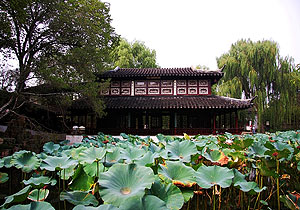Humble Administrator's Garden

The Humble Administrator's Garden, the largest of the four great classic gardens in Suzhou, is located in the old area of the city. It had served as private residence since it was built by a scholar called Lu Guiming in Tang Dynasty. It was renamed Humble Administrator's Garden when Wang Xianchen, an envoy during Zhengde Reign in Ming Dynasty. Unsuccessful in his political career, Wang went to Suzhou for retreat and bought the garden, and spent 16 years reconstructing it with the help of Wen Zhenming, a great artist at that time. It's said that, Cao Xueqin, who spent his teenager years in the Garden, was more or less inspired by the Garden in his splendid description in the literature classic Red Dream Mansion. Through splendors and decays, parts of the Garden were rejoined and restored to its late Qing appearance in 1955. In 1997, it was listed on World Heritage Site by UNESCO.
Covering an area of 51,950 square meters (12.84 acres), the Garden boasts a total amount of 48 buildings, 101 tablets, 40 stele, 21 precious ancient trees, and more than 700 bonsai. It is divided into three parts, the east, center and west. The eastern garden comes to sight after entering the gate, the former Guiyuan Tianju (Dwelling upon Return to the Countryside) built in 1635. Most of the eastern garden was newly built due to its early decay. With a pond at the center, pine bamboos, trees and flowers are planted and rockeries are set in a vast lawn and low mounds, providing visitors with refresh and clarity. Main structures include Shu Xiang Guan (Fragrant Sorghum Hall), Tian Quan Ting (Celestial Spring Pavilion), Furong Xie (Lotus Pavilion), on a north-to-south axis, with the Fang Yan Ting (Far Away Looking Pavilion) on top of a hill in the pond.
Haitang Chunwu (Pavilion of Haitang Flowers Blossoming in Spring) divides the eastern part from the central garden, the former Humble Administrator's Garden and the essence of the Garden, featuring Lotus growing in blossom in the winding clear water, marvelous mountains and rockeries. A lake is at the center and cluster of gardens and courts lie in the south of it. The main structure, the Yuan Xiang Ting (Distant Fragrance Hall) stands in the middle, flanked by Xiu Yi Ting (Embroidery Pavilion) and Ling Long Guan (Dainty Hall). In the middle of the lake rise two hills, on top of which stand two pavilions called Xuexiang Yunwei Ting (Fragrant Snow and Azure Sky Pavilion) in the west hill and Dai Shuang Ting (Waiting for the Frost Pavilion) in the east hill. Other famous buildings include Xiu Yi Xuan (Embroidery Pavilion), Yi Yu Xuan (Leaning Jade Pavilion), Ting Yu Xuan (Listening to the Rain Veranda), Zhiqing Yiyuan (A Pure Mind Thinks Deep), and Yu Lan Tang (the Magnolia Hall). Jian Shan Lou, (Mountain in View Tower) stands northwest of the lake, from which visitors can see a Pagoda that seems to be within reach in the garden, yet it is in fact miles away. It is said that Wang wanted to buy the Pagoda but the owner, a monk, wouldn't sell it; hence the built technique, called "borrow view from afar".
To the west of the lake lies Bieyou Dongtian (Pavilion Leading to a New World), the beginning of the western part, the Buyuan Garden (Subsidiary Garden) featuring a corridor built over the water. The main halls, Saliu Yuanyang Guan (36 Pairs of Mandarin Ducks' Hall) and Shiba Mantuohua Guan (18 Camellias Hall), are connected with Liu Ting Ge (Stay and Listen Pavilion) across the lake through a bridge, while the Liangyi Guan (Good for Both Families Pavilion) on top of a hill near the main halls. Other structures include Daoying Lou (Inverted Reflection Building), Fucui Ge (Floating Green Tower), Li Ting (Bamboo Hat Pavilion), Yushui Tongzuo Xuan (With Whom Shall I sit Pavilion) and Taying Ting (Pagoda Reflection Pavilion) on a north-to-south axis. Going further west there is a bonsai garden with over 700 bonsai in it to be appreciated.
Suzhou Museum is right next to the Garden, where there is over 15,000 pieces of collections, and most notable are paintings and calligraphy in Ming and Qing Dynasty. Entry is free. Don't miss it.